Geogrid-Enhanced Modulus and Stress Distribution in Clay Soil
Abstract
:1. Introduction
2. Model Footing Tests
2.1. Material Properties and Test Setup
2.2. Test Section Preparation
2.3. Experimental Testing Program
3. Results and Analysis
3.1. Modulus Analysis
3.2. Stress Distribution Analysis
3.3. Discussion
4. Conclusions
- A stiffer load-settlement response was observed when geogrid reinforcement was included, indicating that the reinforced soil in this study exhibited a higher modulus compared to the unreinforced soil. This modulus improvement increased with the settlement ratio (s/B). At a settlement ratio of 5%, the modulus of the clayey soil increased up to 65% and 56% with the inclusion of geogrid reinforcement for laboratory and large-scale field model tests, respectively.
- Laboratory model tests consistently showed a higher improvement in the modulus than the large-scale field model test in this study. For laboratory model tests with five layers of GG2 geogrid, the modulus improvement factor (IFE) ranged from 1.49 at a settlement ratio of 1% to 1.65 at a settlement ratio of 5%. In comparison, the modulus improvement factor (IFE) of large-scale field model test sections with five layers of GG2 geogrid varied from 1.16 to 1.56 as the settlement ratio increased from 1% to 5%.
- The modulus of the reinforced clayey soil exhibited a good correlation with the reinforced ratio, remaining almost constant for test sections with the same reinforced ratio and increasing with an increase in the reinforced ratio.
- The disparity in the modulus performance between laboratory and large-scale field model tests may be attributed to the reinforcement spacing, which affects the degree of interaction among neighboring reinforcement layers.
- The reinforced ratio for laboratory model test sections is much higher than that for large-scale field model test sections. The laboratory model tests could thus overestimate the modulus benefit of geogrid reinforcement.
- The stress distribution angles estimated for the reinforced sections were higher comparted to the unreinforced sections. The stress distribution improvement decreased as the surface pressure increased. The stress distribution improvement factor ranged from 1.50 at a surface pressure of 234 kPa to 1.30 at a surface pressure of 936 kPa with the inclusion of five layers of GG2 geogrid for both laboratory and large-scale field model tests.
- Both the modulus improvement and stress distribution improvement of the reinforced clayey soil increased with an increase in the tensile modulus of the geogrid.
- The proposed modulus improvement factor (IFE) and stress distribution improvement factor can assist engineers in estimating the immediate and consolidation settlement of a reinforced soil foundation.
Funding
Data Availability Statement
Conflicts of Interest
References
- Adams, M.T.; Collin, J.G. Large model spread footing load tests on geosynthetic reinforced soil foundations. J. Geotech. Geoenviron. Eng. 1997, 123, 66–72. [Google Scholar] [CrossRef]
- Albuja-Sánchez, J.; Cóndor, L.; Oñate, K.; Ruiz, S.; Lal, D. Influence of geogrid arrangement on the bearing capacity of a granular soil on physical models and its comparison to theoretical equations. SN Appl. Sci. 2023, 5, 250. [Google Scholar] [CrossRef]
- Biswas, A.; Krishna, A.M.; Dash, S.K. Behavior of geosynthetic reinforced soil foundation systems supported on stiff clay subgrade. Int. J. Géoméch. 2016, 16, 04016007. [Google Scholar] [CrossRef]
- Chenari, R.J.; Bathurst, R.J. Bearing capacity of strip footings seated on unreinforced and geosynthetic-reinforced granular layers over spatially variable soft clay deposits. J. Geotech. Geoenviron. Eng. 2023, 149, 04023034. [Google Scholar] [CrossRef]
- Das, B.M.; Shin, E.C.; Omar, M.T. The bearing capacity of surface strip foundations on geogrid-reinforced sand and clay? A comparative study. Geotech. Geol. Eng. 1994, 12, 1–14. [Google Scholar] [CrossRef]
- DeMerchant, M.; Valsangkar, A.; Schriver, A. Plate load tests on geogrid-reinforced expanded shale lightweight aggregate. Geotext. Geomembr. 2002, 20, 173–190. [Google Scholar] [CrossRef]
- Guido, V.A.; Chang, D.K.; Sweeney, M.A. Comparison of geogrid and geotextile reinforced earth slabs. Can. Geotech. J. 1986, 23, 435–440. [Google Scholar] [CrossRef]
- Lavasan, A.A.; Ghazavi, M. Behavior of closely spaced square and circular footings on reinforced sand. Soils Found. 2012, 52, 160–167. [Google Scholar] [CrossRef]
- Lingwal, P.; Gupta, A.K. Bearing capacity of clayey soil reinforced with geogrid. Adv. Comput. Methods Geomech. 2020, 1, 173–183. [Google Scholar]
- Neupane, M.; Han, J.; Parsons, R.L. Experimental and analytical evaluations of mechanically-stabilized layers with geogrid over weak subgrade under static loading. In Proceedings of the Geo-Congress 2020, Minneapolis, MN, USA, 25–28 February 2020. [Google Scholar]
- Roy, S.S.; Deb, K. Bearing capacity of rectangular footings on multilayer geosynthetic-reinforced granular fill over soft soil. Int. J. Géoméch. 2017, 17, 04017069. [Google Scholar]
- Pincus, H.; Shin, E.; Das, B.; Puri, V.; Yen, S.-C.; Cook, E. Bearing capacity of strip foundation on geogrid-reinforced clay. Geotech. Test. J. 1993, 16, 534–541. [Google Scholar] [CrossRef]
- Useche-Infante, D.; Martinez, G.A.; Arrúa, P.; Eberhardt, M. Experimental study of behaviour of circular footing on geogrid-reinforced sand. Géoméch. Geoengin. 2022, 17, 45–63. [Google Scholar] [CrossRef]
- Xu, Y.; Yan, G.; Williams, D.J.; Serati, M.; Scheuermann, A.; Vangsness, T. Experimental and numerical studies of a strip footing on geosynthetic-reinforced sand. Int. J. Phys. Model. Geotech. 2020, 20, 267–280. [Google Scholar] [CrossRef]
- Chen, Q. An Experimental Study on Characteristics and Behavior of Reinforced Soil Foundation. Doctoral Dissertation 3361, Louisiana State University, Baton Rouge, LA, USA, 2007. [Google Scholar]
- Chen, Q.; Abu-Farsakh, M. Mitigating the bridge end bump problem: A case study of a new approach slab system with geosynthetic reinforced soil foundation. Geotext. Geomembr. 2016, 44, 39–50. [Google Scholar] [CrossRef]
- Huang, C.-C.; Al-Aghbari, M.Y.; Mohamedzein, Y.E.-A. Ultimate bearing capacity of saturated reinforced horizontal ground. Geosynth. Int. 2016, 23, 1–8. [Google Scholar] [CrossRef]
- Mosallanezhad, M.; Hataf, N.; Taghavi, S.S. Experimental and large-scale field tests of grid-anchor system performance in increasing the ultimate bearing capacity of granular soils. Can. Geotech. J. 2016, 53, 1047–1058. [Google Scholar] [CrossRef]
- Huang, C.-C.; Tatsuoka, F. Bearing capacity of reinforced horizontal sandy ground. Geotext. Geomembr. 1990, 9, 51–82. [Google Scholar] [CrossRef]
- Chen, Q.; Abu-Farsakh, M. Ultimate bearing capacity analysis of strip footings on reinforced soil foundation. Soils Found. 2015, 55, 74–85. [Google Scholar] [CrossRef]
- Michalowski, R.L. Limit loads on reinforced foundation soils. J. Geotech. Geoenviron. Eng. 2004, 130, 381–390. [Google Scholar] [CrossRef]
- Sharma, R.; Chen, Q.; Abu-Farsakh, M.; Yoon, S. Analytical modeling of reinforced soil foundation. Geotextile Geomembr. 2009, 27, 63–72. [Google Scholar] [CrossRef]
- Huang, C.C. Settlement of footings on reinforced level sandy ground at peak footing loads. Geosynth. Int. 2011, 18, 124–136. [Google Scholar] [CrossRef]
- Huang, C.C.; Hong, L.I.L. Ultimate bearing capacity and settlement of footings on reinforced sandy ground. Soils Found. 2000, 40, 67–73. [Google Scholar] [CrossRef] [PubMed]
- Raja, M.N.A.; Shukla, S.K. Multivariate adaptive regression splines model for reinforced soil foundations. Geosynth. Int. 2021, 28, 368–390. [Google Scholar] [CrossRef]
- Khosrojerdi, M.; Xiao, M.; Qiu, T.; Nicks, J. Nonlinear equation for predicting the settlement of reinforced soil foundations. J. Geotech. Geoenviron. Eng. 2019, 145, 04019013. [Google Scholar] [CrossRef]
- Raja, M.N.A.; Shukla, S.K. Predicting the settlement of geoysnthetic-reinforced soil foundations using evolutionary artificial intelligence technique. Geotextile Geomembr. 2021, 49, 1280–1293. [Google Scholar] [CrossRef]
- ASTM Standard D 1196-93 (2004); Standard Test Method for Nonrepetitive Static Plate Load Tests of Soils and Flexible Pavement Components, for Use in Evaluation and Design of Airport and Highway Pavements. ASTM International: West Conshohocken, PA, USA, 2005.
- Zornberg, J.G.; Morsy, A.M.; Kouchaki, B.M.; Christopher, B.; Leshchinsky, D.; Han, J.; Tanyu, B.F.; Gebremariam, F.T.; Shen, P.; Jiang, Y. Defining the Boundary Conditions for Composite Behavior of Geosynthetic-Reinforced Soil Structures; National Cooperative Highway Research Program (NCHRP) Final Report No. 24-41; Transportation Research Board: Washington, DC, USA, 2018. [Google Scholar]
- Coronel, J.J. Frictional Interaction Properties between Geomaterials and Geosynthetics. Master’s Thesis, Louisiana State University, Baton Rouge, LA, USA, 2006. [Google Scholar]

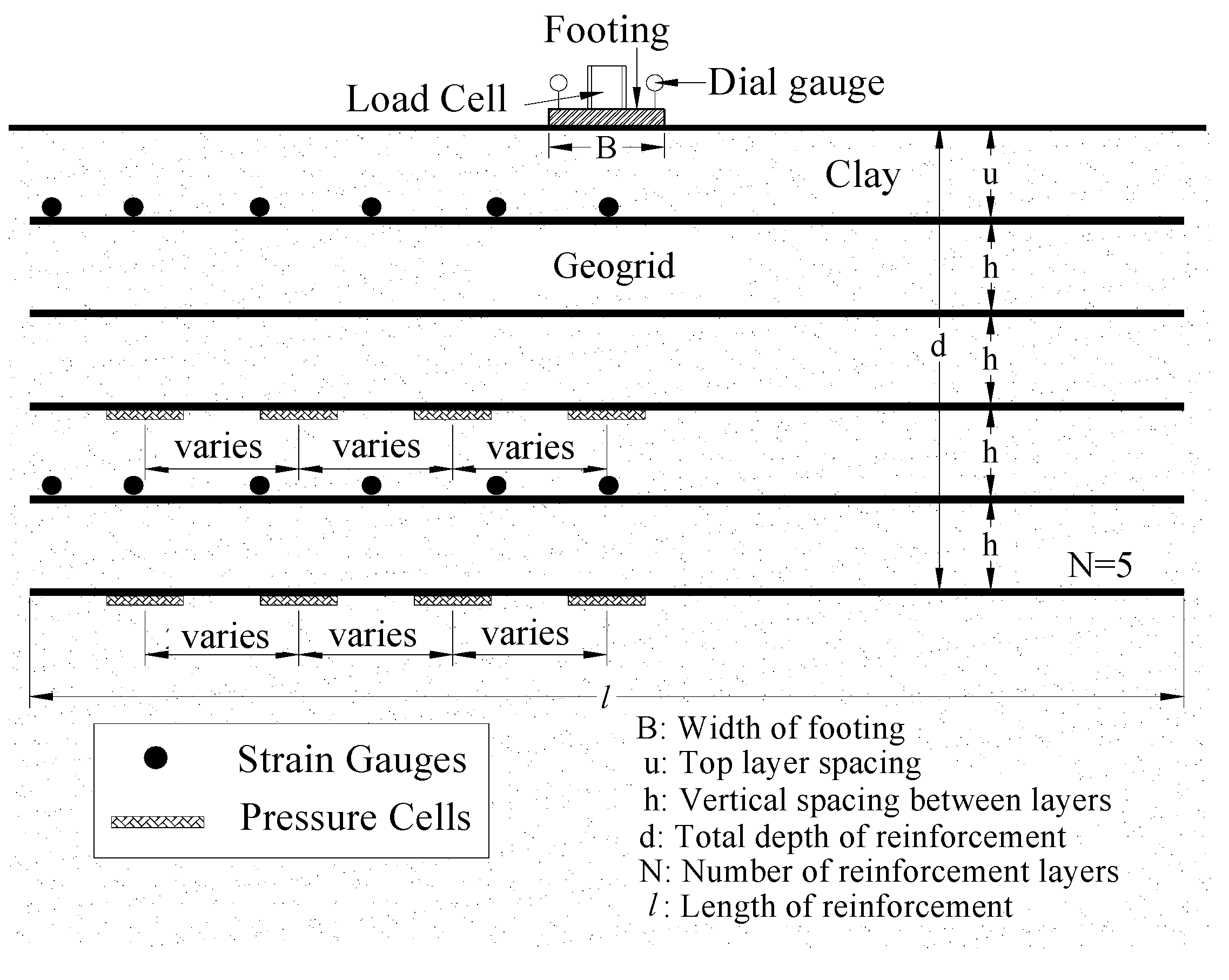
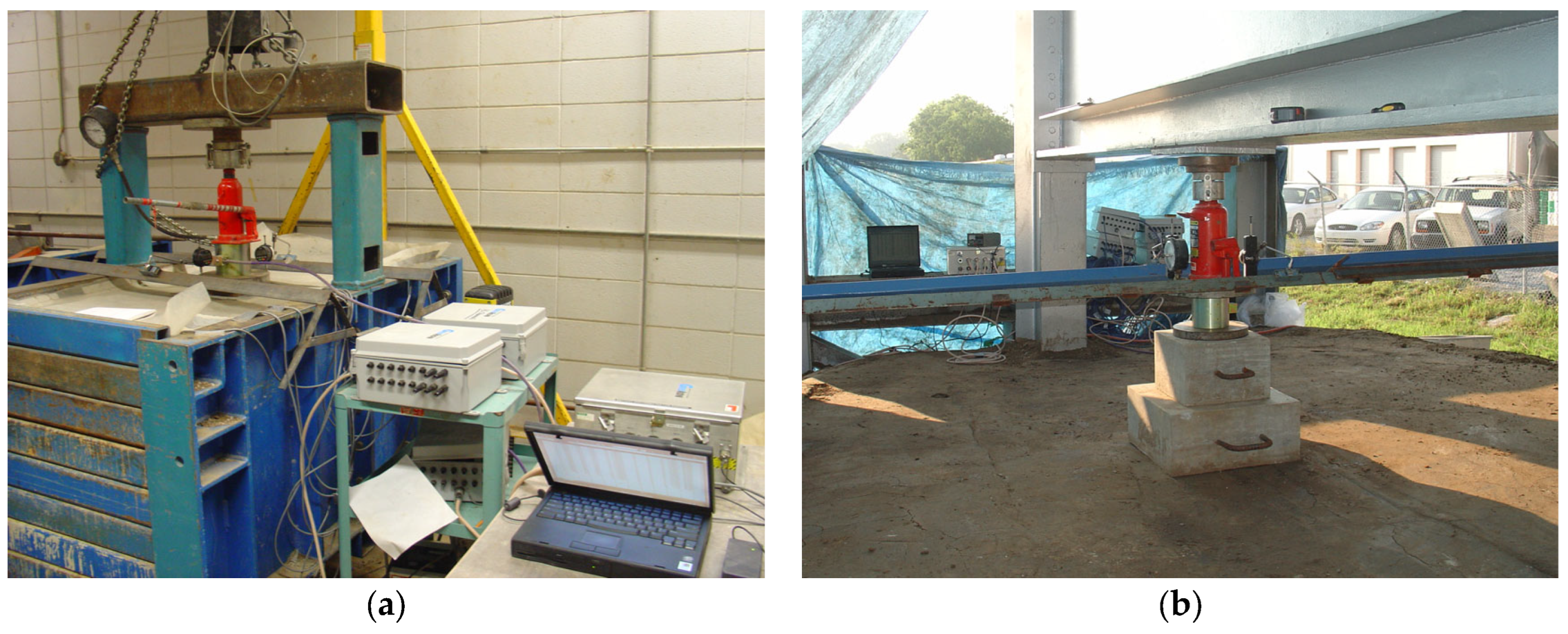
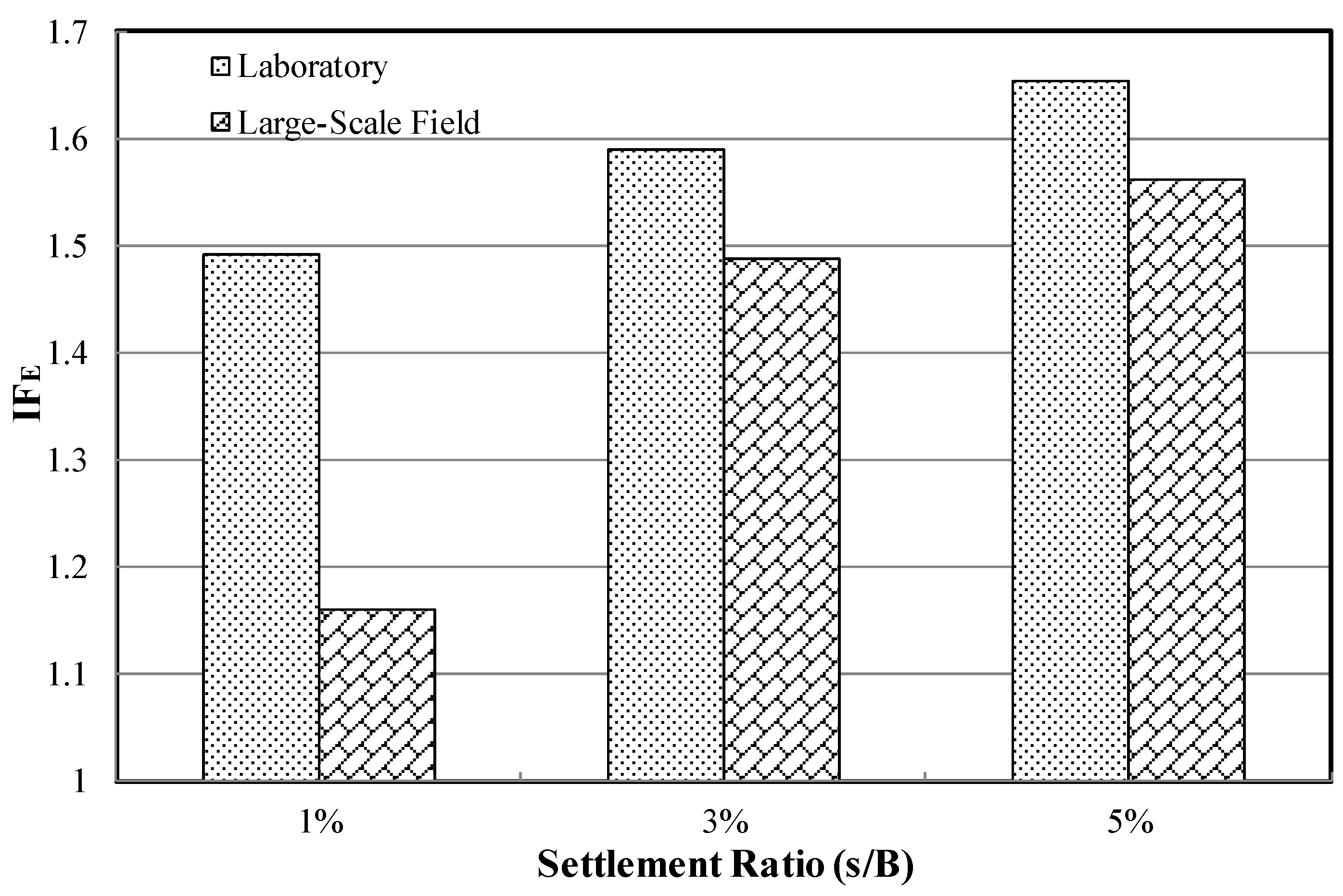
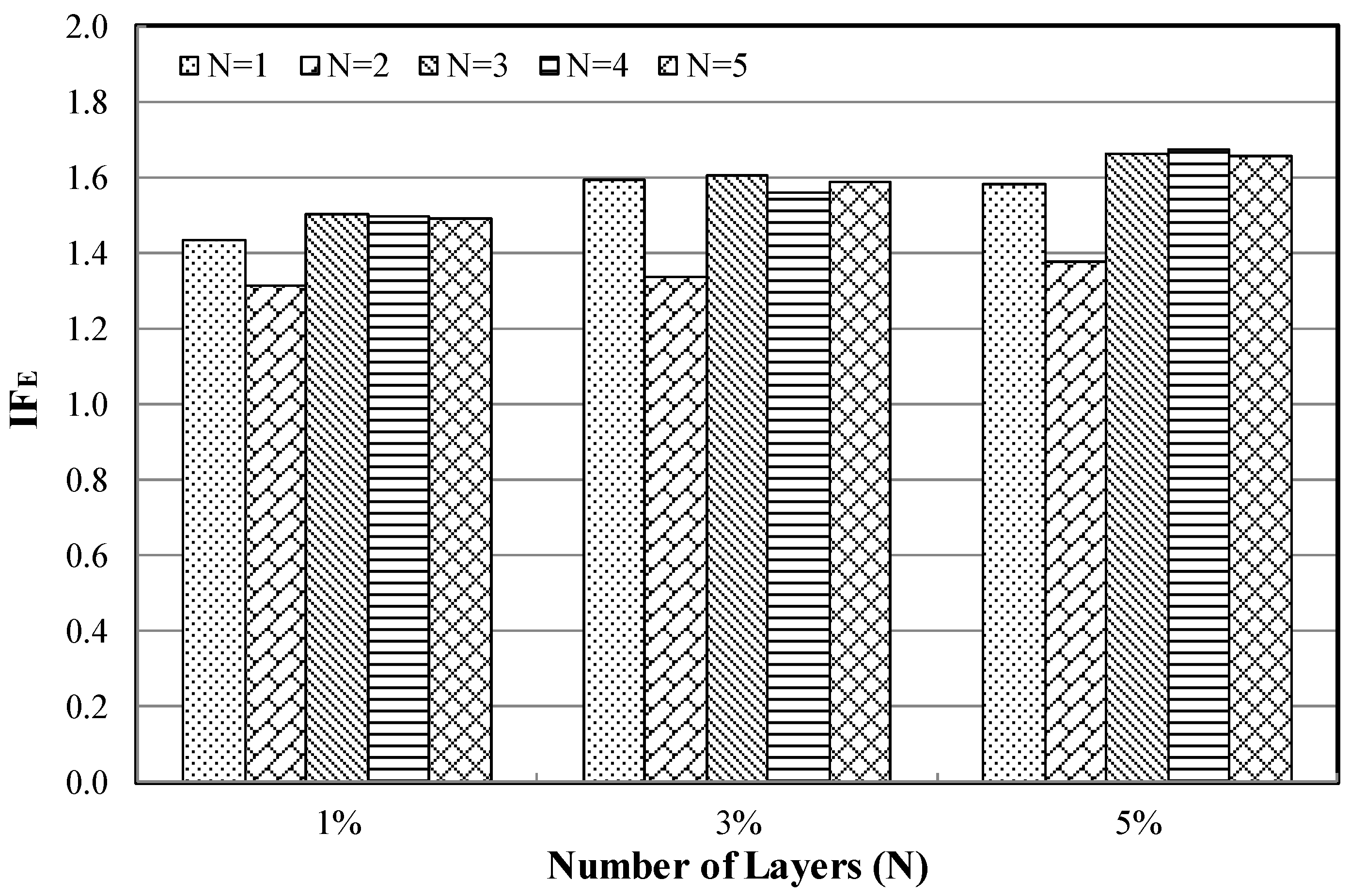

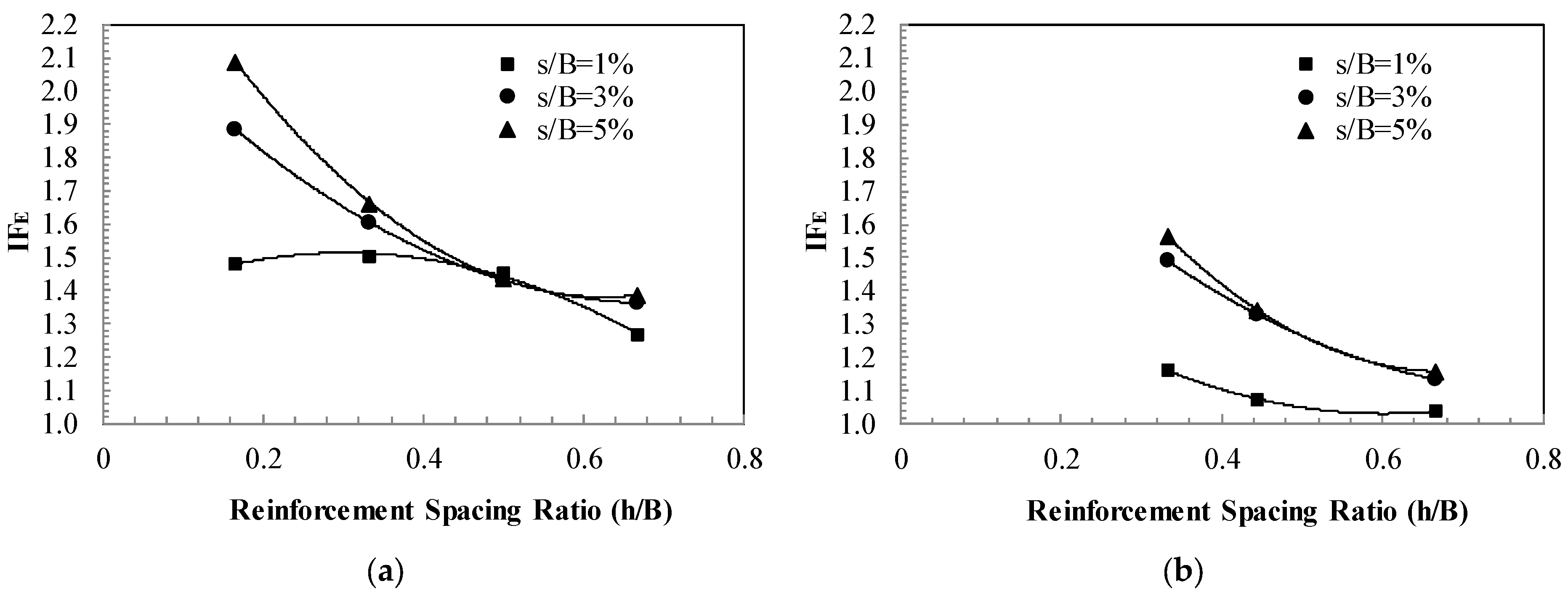
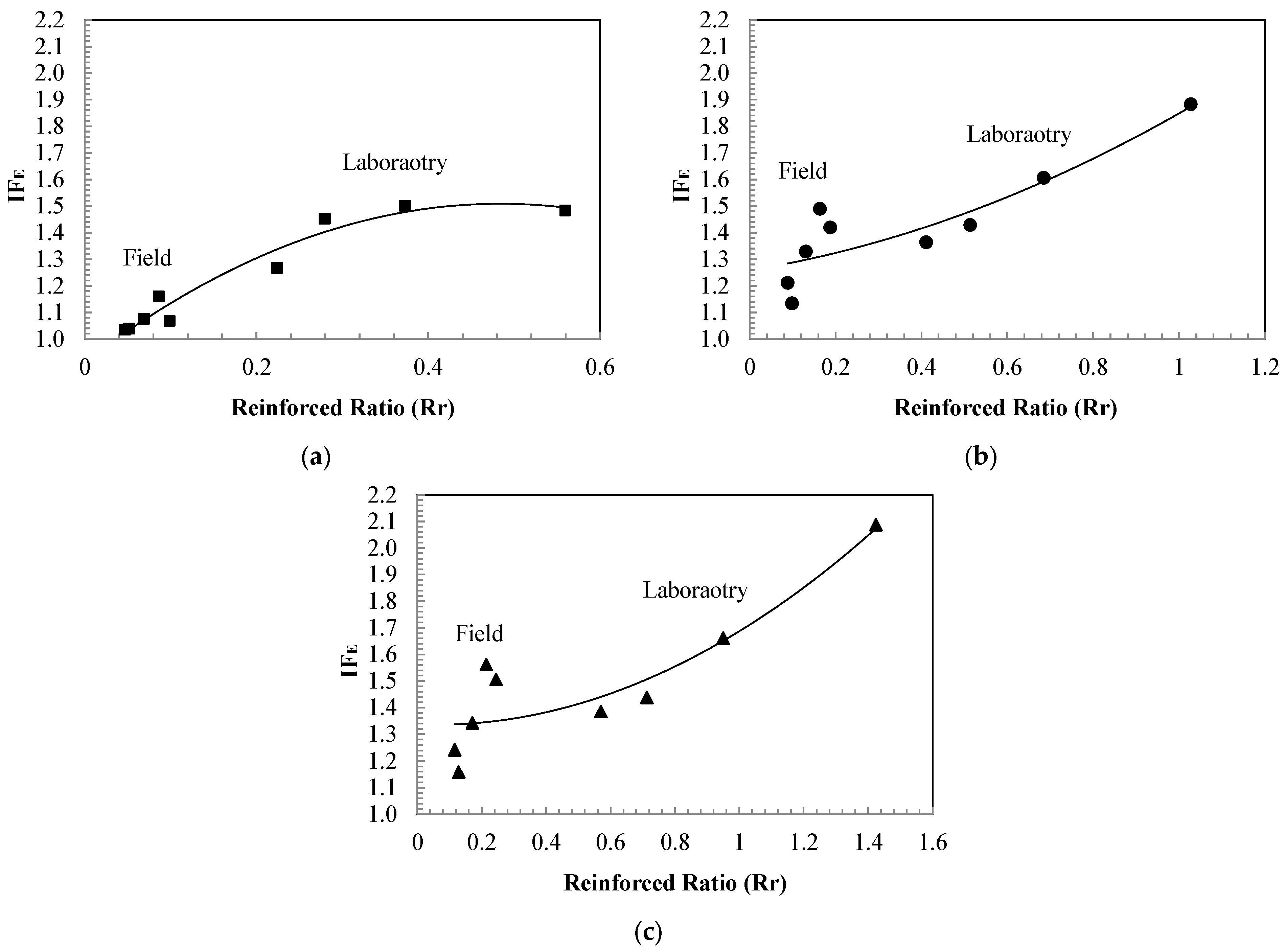


| Reinforcement | Polymer Type | T a, kN/m | E b, kN/m | Aperture Size, mm | ||
|---|---|---|---|---|---|---|
| MD c | CD d | MD c | CD d | |||
| GG1 geogrid | Polypropylene | 3.6 | 5.1 | 182 | 255 | 33 × 33 |
| GG2 geogrid | Polypropylene | 5.5 | 7.4 | 274 | 372 | 33 × 33 |
| GG3 geogrid | Polypropylene | 8.5 | 10.0 | 425 | 500 | 25 × 30.5 |
| Reinforcement Configuration | N | u mm | h mm | |
|---|---|---|---|---|
| Laboratory model tests | Unreinforced | … | … | … |
| GG2 | 1, 2, 3, 4, 5 | 51 | 51 | |
| GG2 | 3 | 51 | 25, 51, 76, 102 | |
| Large-scale model tests | Unreinforced | … | … | … |
| GG1, GG2, GG3 | 4 | 152 | 203 | |
| GG2 | 3 | 152 | 305 | |
| GG2 | 4 | 152 | 203 | |
| GG2 | 5 | 152 | 152 |
| Test Section | s/B = 1% | s/B = 3% | s/B = 5% | ||||
|---|---|---|---|---|---|---|---|
| Geogrid | N | u/B | h/B | E, MPa | E, MPa | E, MPa | |
| Large-scale field model tests | Unreinforced | 24.5 | 13.0 | 9.9 | |||
| GG1 | 4 | 0.444 | 0.444 | 25.4 | 15.7 | 12.3 | |
| GG2 | 3 | 0.667 | 0.667 | 25.5 | 14.7 | 11.5 | |
| GG2 | 4 | 0.444 | 0.444 | 26.4 | 17.2 | 13.3 | |
| GG2 | 5 | 0.333 | 0.333 | 28.5 | 19.3 | 15.5 | |
| GG3 | 4 | 0.444 | 0.444 | 26.2 | 18.4 | 14.9 | |
| Laboratory Model Tests | Unreinforced | 17.0 | 9.3 | 6.7 | |||
| GG2 | 1 | 0.333 | … | 24.4 | 14.8 | 10.6 | |
| GG2 | 2 | 0.333 | 0.333 | 22.4 | 12.4 | 9.2 | |
| GG2 | 3 | 0.333 | 0.333 | 25.6 | 14.9 | 11.1 | |
| GG2 | 4 | 0.333 | 0.333 | 25.6 | 14.5 | 11.2 | |
| GG2 | 5 | 0.333 | 0.333 | 25.4 | 14.8 | 11.1 | |
| GG2 | 3 | 0.333 | 0.167 | 25.3 | 17.5 | 14.0 | |
| GG2 | 3 | 0.333 | 0.5 | 24.8 | 13.3 | 9.6 | |
| GG2 | 3 | 0.333 | 0.667 | 21.6 | 12.7 | 9.3 | |
Disclaimer/Publisher’s Note: The statements, opinions and data contained in all publications are solely those of the individual author(s) and contributor(s) and not of MDPI and/or the editor(s). MDPI and/or the editor(s) disclaim responsibility for any injury to people or property resulting from any ideas, methods, instructions or products referred to in the content. |
© 2023 by the author. Licensee MDPI, Basel, Switzerland. This article is an open access article distributed under the terms and conditions of the Creative Commons Attribution (CC BY) license (https://creativecommons.org/licenses/by/4.0/).
Share and Cite
Chen, Q. Geogrid-Enhanced Modulus and Stress Distribution in Clay Soil. Geotechnics 2024, 4, 41-53. https://doi.org/10.3390/geotechnics4010003
Chen Q. Geogrid-Enhanced Modulus and Stress Distribution in Clay Soil. Geotechnics. 2024; 4(1):41-53. https://doi.org/10.3390/geotechnics4010003
Chicago/Turabian StyleChen, Qiming. 2024. "Geogrid-Enhanced Modulus and Stress Distribution in Clay Soil" Geotechnics 4, no. 1: 41-53. https://doi.org/10.3390/geotechnics4010003
APA StyleChen, Q. (2024). Geogrid-Enhanced Modulus and Stress Distribution in Clay Soil. Geotechnics, 4(1), 41-53. https://doi.org/10.3390/geotechnics4010003




